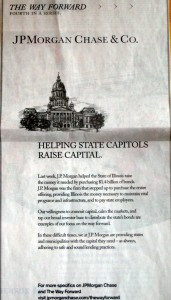Month: December 2008
Frozen Vortex
Check out this bizarre natural phenomenon. Make sure to play the movie.
Stable vortexes form at the ends of bends in rivers as the water that accelerates on the outside of a bend collides with the slower-moving water that traversed the inside of the bend. The velocity sheer produces a vortex. Apparently, an ice pan formed in the center of the stable vortex and then slowly grew until it reached the turbulent edge of the vortex. The turbulence at the edge prevented ice from forming leaving a lubricating liquid layer that lets the ice pan rotate in the vortex.
Neat!
Municipal Bonds… and Illinois
MUNICIPAL BONDS
A difficulty with finance is that statistics are all backwards-looking. For instance, there were umpteen articles about how stocks “return x% over y number of years” or that “residential real estate is a solid investment based on returns in area x over y number of years”. We all know how those assumptions turned out.
While research is useful and assumptions need to be made, a crucial error that has lead to much of our financial malaise is due to retaining assumptions too long rather than chucking them aside when the underlying facts on the ground change. You also need to be aware of shifts in sentiment and try to anticipate what is going to happen next.
Specifically, municipal bonds have historically had a low default rate, less than 1%. And when they do default, investors generally have a relatively high “recovery percentage” (as opposed to Lehman when creditors received 7 cents on every dollar owed). Many investors view them as almost as safe as the debt of the Federal government. Municipal bonds are (generally) tax-free, so a municipal bond can have a lower debt coupon and still attract as many investors as a tax-adjusted amount from a corporate bond sale. I am generally speaking of general obligation debt, not the revenue bonds that might be tied to corporations or other initiatives (these carry a higher coupon and default rate).
Happy Channukah

UPDATE: This is a nice column about Channukah (via Ron).
UPDATE 2: Yes, the spelling. I have no idea what is correct. Until recently I would have said it doesn’t matter, but now we have search engines, so maybe it does.

